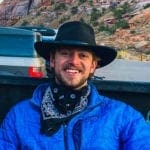|
Getting your Trinity Audio player ready...
|
Established in 1971
Capitol Reef National Park offers visitors a stunning array of sights: immense domed formations, cliffs and buttes in vibrant colors, remarkable geologic features, and a tranquil desert atmosphere. Once called the land of the sleeping rainbow by native Americans, all these wonders are waiting to be discovered on the scenic drives and hiking trails throughout the park.
Capitol Reef may be Utah’s most underrated National Park. It encompasses over 240,000 acres, covering some of the most striking geological features in the state, which anyone who has visited Utah will tell you is nothing to shrug at. In fact, the park is so unique that its defining feature, a 100-mile long uplift in the earth’s crust, has its own geological name – The Waterpocket Fold. In short, Capitol Reef is a one-of-a-kind fortress of sandstone towers filled with historical and archaeological treasures.
But Capitol Reef’s isolation from major cities makes it more of a chore to get to, and its long, narrow shape makes it hard to explore in its entirety. There are nooks and crannies of the park which are (comparatively) rarely set foot in. It’s not the kind of place you’d recommend to someone who wants to see it all in an afternoon and be back to a comfy hotel room by sundown. But if you’re willing to go the distance, Capitol Reef will reward you right off the bat with strange, mysterious, and awe-inspiring sights and experiences you can’t get anywhere else.
If that last sentence describes you, then you’re in luck. We’ve compiled a comprehensive guide on Capitol Reef National Park to showcase everything about the park, some of the big reasons to go, and a list of things to do while you’re there. This is Capitol Reef National Park, in a nutshell.
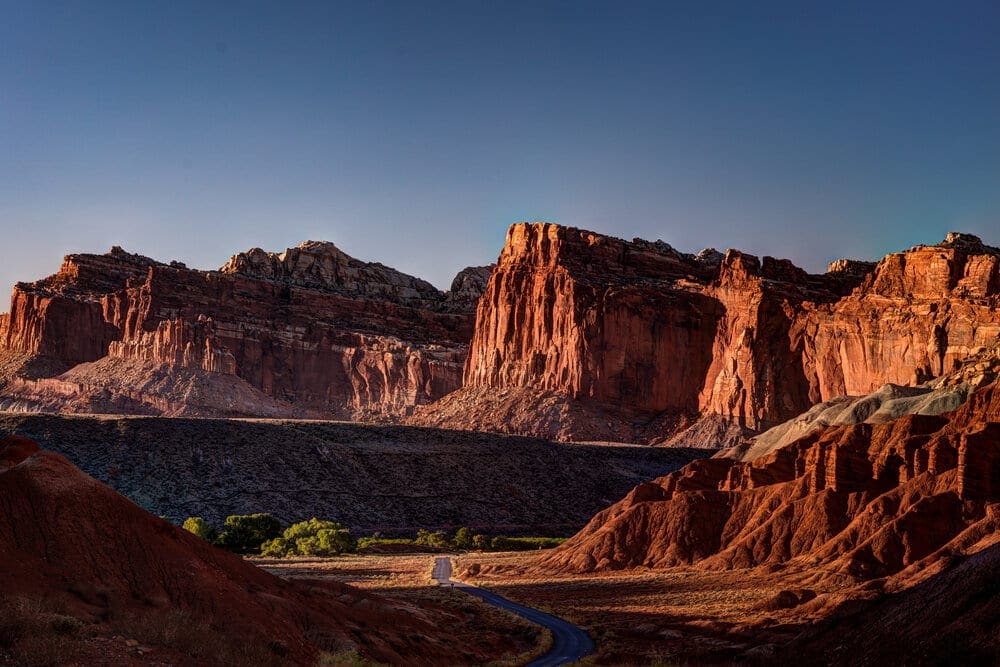
Scenic Drive in Capitol Reef National Park, Utah.
Looking For An Amazing Adventure? Book A Guided, Multiday Hiking Adventure in Capitol Reef National Park with REI Adventures. Hike the Southwest’s scenic and exhilarating trails, learning about ancient cultures and Utah’s geological and natural history from REI’s guides.
Table of Contents:
Article Navigation: Click on any of the listed items in the table of contents below to jump to that section of the article. Similarly, clicking on any large, white section header will jump you back to the Table of Contents.
- History, Summarized
- Geology, In Layman’s Terms
- Flora, Fauna, and Desert Ecology
- Where to Stay
- Main Attractions
- Treat Yourself To A Guided Adventure
- Nearby Cities
- The Whole Desert in Cross-Section
History, Summarized
Capitol Reef was first “discovered” in the modern day by Almon H. Thompson, a member of the second expedition to explore the Colorado River led by Major J.W. Powell. Thompson made a vast overland detour away from the Colorado to find the mouth of the Dirty Devil River, which led him through the Waterpocket Fold. After Thompson’s return, the area would not be successfully settled for some time due to it’s ruggedness.
However, long before white explorers entered the Capitol Reef area, it was populated by the Fremont native peoples. Little is understood about the way they lived, though they left behind a great deal. We know that they existed in the area around the year 1000 CE, and disappeared mysteriously in the 1200s. They practiced agriculture, built houses and granaries from stone, and produced fascinating artworks which they etched into the brilliantly-colored rocks of Capitol Reef. Remnants of their rich, colorful culture can be found all over the southwest in abandoned dwellings, pot fragments, and petroglyphs, and Capitol Reef is no exception.
By the 1870s and ‘80s, a few towns in and around the Reef had been settled by newly-arrived Mormon pioneers. Torrey, Fruita (not Colorado, the other one), and Caineville were founded to support a semi-militaristic push by the LDS church to drive the modern-day native inhabitants of the area away. Later, the uranium mining industry would boom (and then bust) in the surrounding area, bringing more people to the Capitol Reef for a brief period.
Attempts to legally protect the land began in 1937, when Franklin Delano Roosevelt named it a National Monument. The name “Capitol Reef” was taken from early settlers, who compared the prominent white domes of the park to the US Capitol building. The park was “upgraded” to National Park status in 1971, permanently preserving the stunning landscape for low-impact recreational use.
The Ultimate Offline GPS Hiking & Ski Maps
See why onX Backcountry is the ultimate GPS navigation app for your outdoor pursuits. Try Today for Free. No credit card required.
Geology, In Layman’s Terms
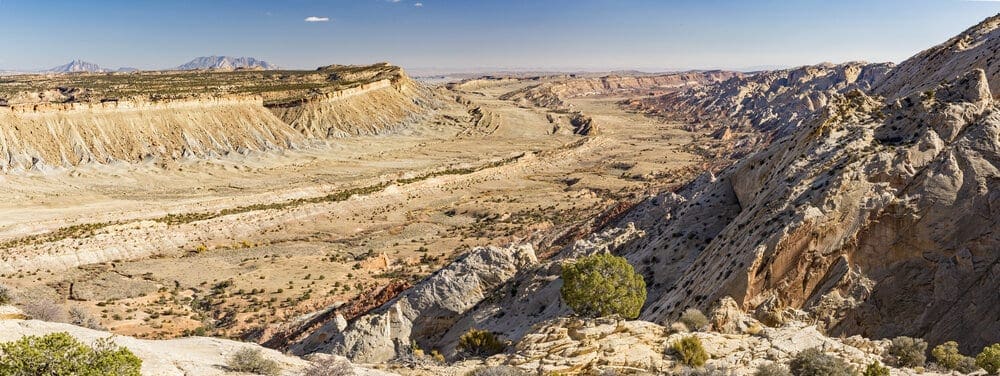
Panoramic view of the Waterpocket Fold in Capital Reef National Park, Utah.
As mentioned above, all of the dramatic landscapes in Capitol Reef exist because of a singular geological formation: the Waterpocket Fold. But what exactly is it? To put it briefly, the Waterpocket Fold is a roughly 100 mile-long uplift, or wrinkle, in the earth’s crust. This creates a massive “step up” moving from east to west, exposing a cross section of different types of sandstone in layers. This type of formation, called a monocline, can be observed in several other places around the world. But the Waterpocket Fold stands out for both its size and the continuousness of its shape. Viewed from space, the park looks like an burnt red wave crashing on a beach, made entirely of stone.
Driving through the park east to west is like flipping through a history book covering hundreds of millions of years. You’ll see each of the uniquely-colored layers of sandstone roll by, and you may even notice that each layer tends to create different rock formations.
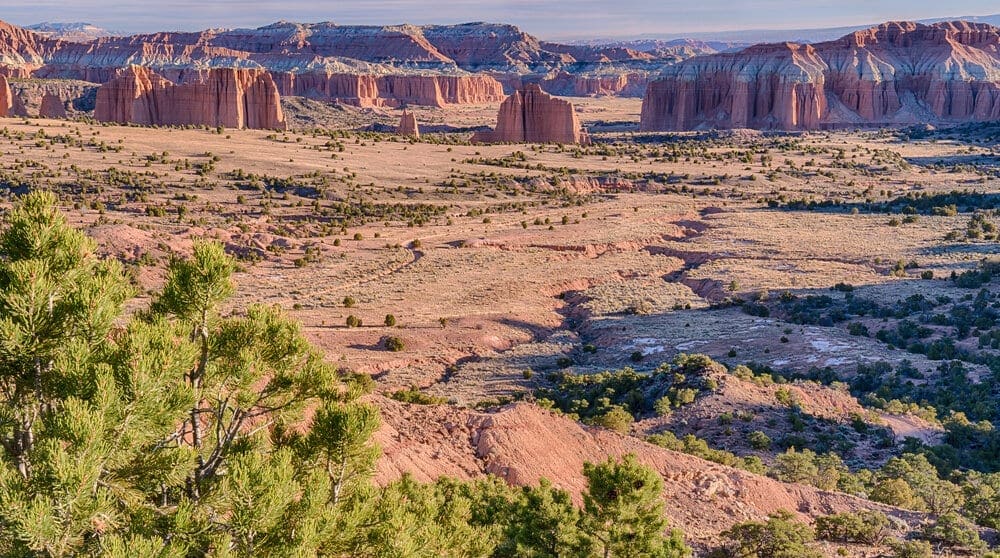
Amazing views from the Cathedral Valley Overlook in Capital Reef National Park, Utah.
One of the most prominent of these are the park’s namesake massive white domes, found on the western side of the Fold. These domes, made of Navajo Sandstone, were once huge sand dunes that slowly fossilized into solid rock. There are also prominent domes of a more yellow-orange color, including the Golden Throne, are made up of Carmel Sandstone. Further north in Cathedral Valley, spiky, gothic pinnacles of Entrada Sandstone rise conspicuously over the flat valley floor. You may also notice large cliffs of Wingate Sandstone, sloping, rocky hills called the Moenkopi Formation, and many, many others.
Support Skyblue Overland™ on Patreon!
If you’d like to support our efforts for a few dollars a month, please subscribe to our Patreon page. Every donation energizes our team to keep writing detailed trail reviews, gear reviews and adventure guides. Thank you!
Flora, Fauna, and Desert Ecology
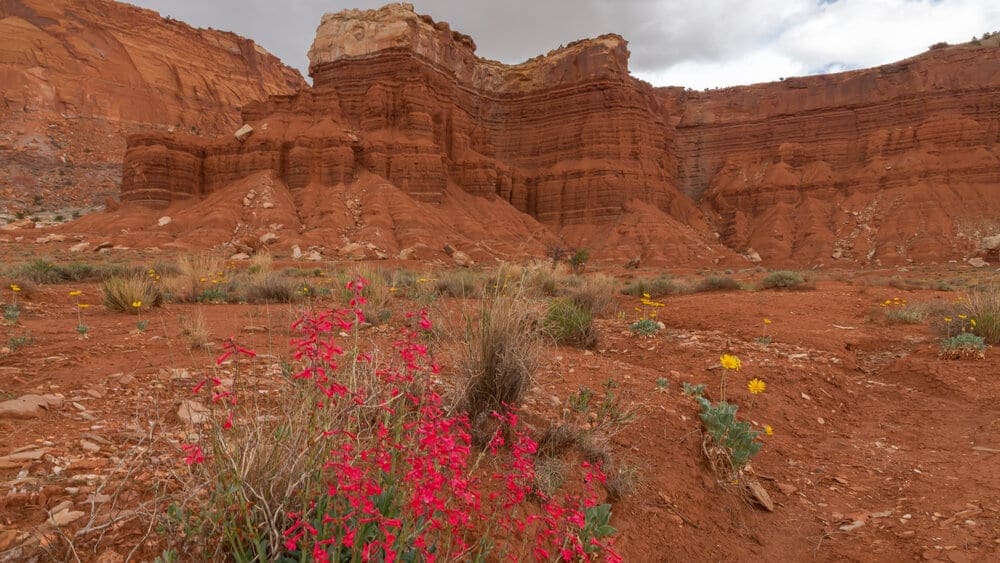
Wildflowers in Cathedral Valley in Capitol Reef National Park, Utah.
Capitol Reef is, of course, a desert. While there you can probably expect to see a pretty good selection of desert-typical plants and animals. Snakes and lizards, ringtails, birds of prey, cacti, piñon pines, juniper trees, and yucca plants are all common here.
But due to the park’s high elevation, there are also a number of plant and animal species you may not expect, but could easily run into as well. Large mammals – including desert bighorn sheep and mountain lions are not uncommon. Smaller mammals more typical of mountain habitats such as beavers and foxes can also be found in the Reef. And there is also a surprising diversity of tree species, from large, leafy black cottonwoods to ponderosa pines, and even bristlecone pines, notably the longest-living organisms on earth. There is also no shortage of different wildflowers and birds in the park.
This incredibly hardy ecosystem would probably not be possible without a single unassuming-looking component holding it all together – that is, cryptobiotic soil. These strange-looking soil crusts are actually made up of hundreds of living things, and serve a number of ecological functions. They grow into coarse, black carpets that trap rainwater, collect nutrients, and allow seeds to germinate in shallow sand. They’re also extremely fragile. Stepping in cryptobiotic soil kills all of the microorganisms in the crust, and after a disturbance it can take decades to return to its previous state. While in the desert it’s important to stick to trails or bare rock surfaces, as removing the ecological foundation of the soil crust can cause untold damage on every other living thing on the landscape.
Where To Stay
Camping is an obvious choice when visiting any National Park. Who wouldn’t want to wake up in the middle of Capitol Reef? You’ll have a few options for overnighting in the park, though a few of them take some extra time and effort to get to.
While camping in the park, be sure to do some stargazing. Capitol Reef is an International Dark Sky Park, with minimal atmospheric light pollution, giving you an interstellar view of the Milky Way.
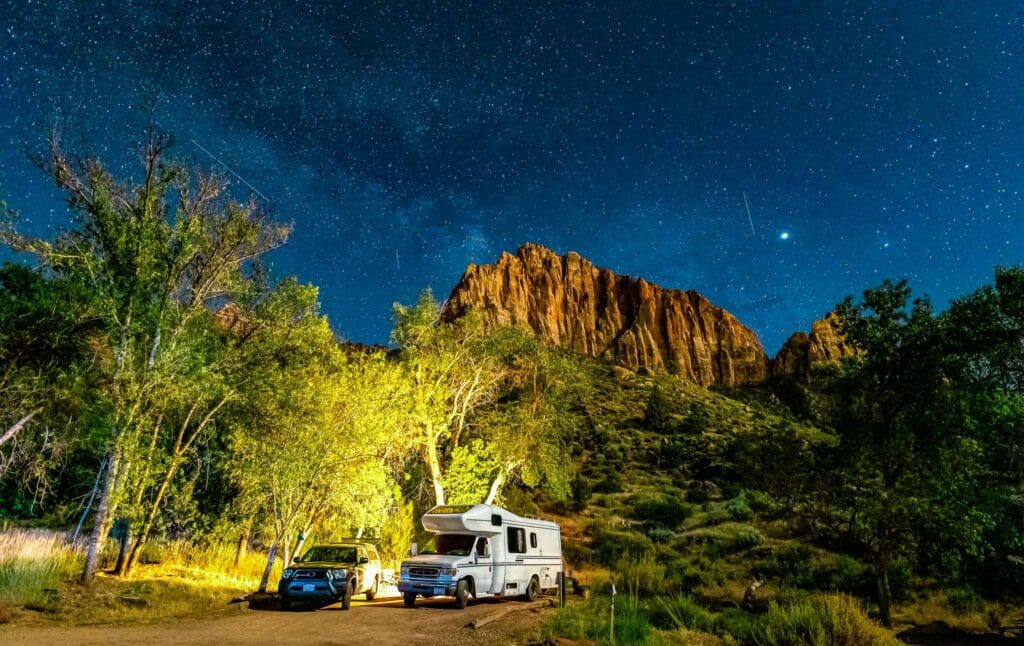
RV Camping under stars at night in Capitol Reef National Park, Utah.
Fruita Campground: This popular campsite is situated next to the Fremont River, beneath towering cottonwood trees and surrounded by historic barns and orchards that were planted by Mormon settlers. There are 71 sites in all, each boasting a picnic table and fire pit, as well as an above ground grill. Unfortunately, there are no individual water, sewage, or electric hookups available. RVs can take advantage of the dump station and potable water fill near Loop A and B’s entrance. Restrooms are present with running water and flush toilets, but no showers. Accessible sites (non-electric) are located close to the restrooms.
Primitive Campgrounds: There are also two primitive (undeveloped) campgrounds in the park. They are free to use, though more remote, and may be more difficult to get to, requiring high clearance and 4WD. Cathedral Valley Campground, located in the Cathedral District has six sites, and Cedar Mesa Campground, located on top of the mesa further south, has five. The solitude of these secluded sites is a selling point all of its own for those willing to drive a little further off the beaten path.
If you’re not up for camping, try these awesome places to stay just outside the park:
Torrey Schoolhouse Bed & Breakfast: As you walk through the hallways of the restored 1914 schoolhouse, you’ll see portraits of students from past generations adorning the walls. Every aspect of this solid brick building on the outside and nostalgic interior will provide a comfortable and luxurious stay for travelers from all over. Located just 10 minutes away from Capitol Reef National Park in Torrey, Utah, the Torrey Schoolhouse B&B Inn provides elegant hardwood floors, beadboard, lath & plaster walls, period lighting fixtures and decor, as well as modern amenities to enjoy during your stay.
Lodge at Red River Ranch: Designed to evoke the memories of the great Western ranches, this immense timber lodge in Teasdale adeptly blends old-fashioned western flair with modern amenities. Beds are adorned with country quilts and Navajo rugs, while the great room is open and inviting.
The stunning red-rock backdrop is perfect for stargazing from the outdoor hot tub. Guests will find their accommodations comfortable, the food and service top notch, the location breathtaking, and the overall experience truly unforgettable. The lodge, resplendent in its classic Western styling, sprawls over two thousand acres of land with breathtaking views of fiery red bluffs.
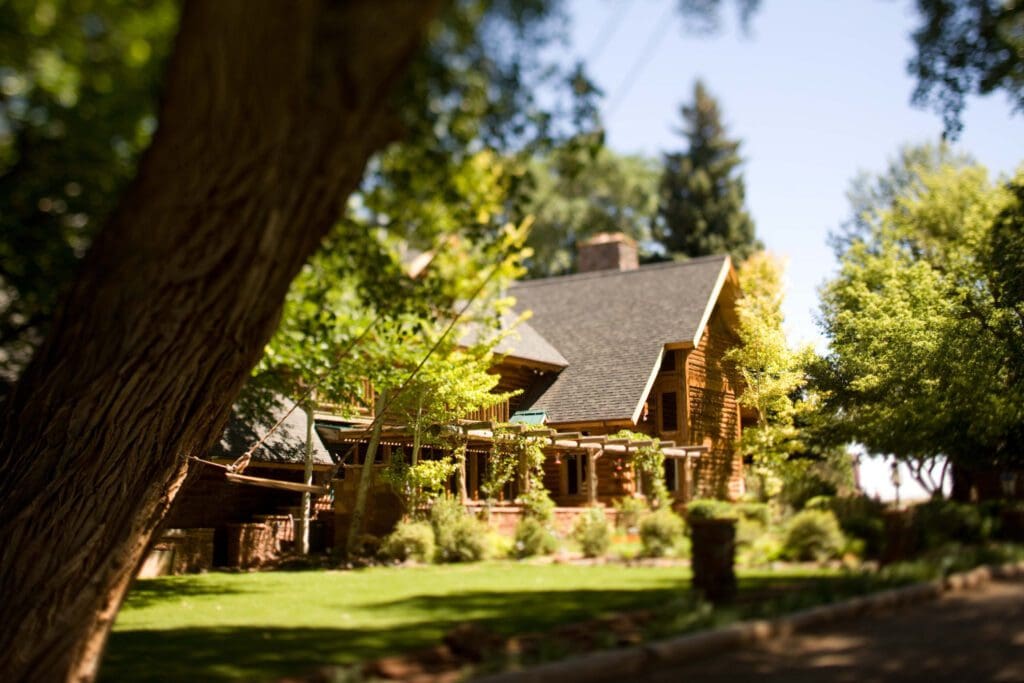
A step into Red River Ranch will make you feel like you’ve stepped into the pages of a Western legend. Each room is decorated with high-quality furnishings and decorations. Photo courtesy of the Lodge at Red River Ranch.
Main Attractions
Most people visit Capitol Reef to see the incredible monoliths and geological oddities of the Waterpocket Fold. You would have trouble seeing every noteworthy formation in just one trip, but quite a few of them can be viewed from the main scenic drive over Highway 24. As you pass through the rapidly-changing landscape of Capitol Reef, keep your eyes peeled for Capitol Dome, The Castle, and Twin Rocks. If you’ve got time for a short hike on your drive, make your way out to Chimney Rock. Venturing south from Fruita, you’ll see the Golden Throne (which you can hike all the way around) and Pectols Pyramid, two of the most imposing domes in the Reef.
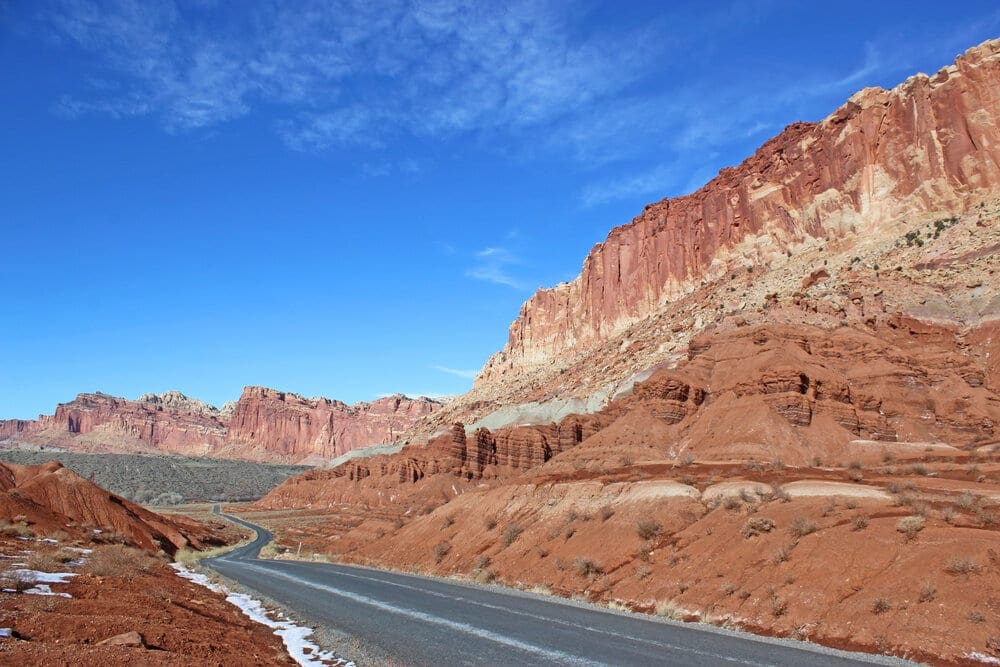
The main scenic drive on Highway 24 is a great way to see the Capitol Reef National Park, Utah
Further north, in Cathedral Valley, the main draws are the Temple of the Sun and Temple of the Moon. These spires of Entrada Sandstone watch over the wide, open valley. They are the quiet, stoic grandeur of the desert personified in stone.
Capitol Reef is also ripe with interesting historical sites, both from the modern era and ancient times. The long-abandoned ghost town of Fruita is full of interesting buildings and remnants from early settlers. The first settlers of the Mormon faith came into Fruita in 1880 and the last one left in 1969. The National Park Service tends to a collection of 2,700 cherry, apricot, peach, pear and apple trees planted by these pioneers. When visiting Fruita, you can sample the fruit when it is ripe or take a picnic amidst the wildlife—deer and birds—that are otherwise rare in this desert land.
Further east along Hwy 24 you’ll find the Behunin Cabin, a more remote site that was once home to a family of fifteen.
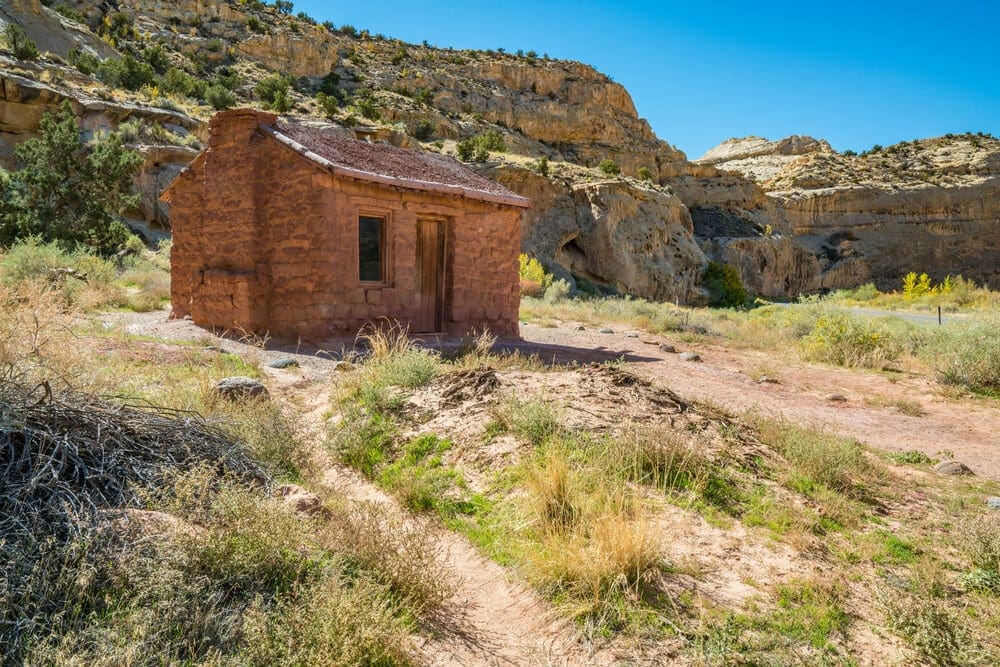
Behunin Cabin in Capitol Reef National Park, Utah was the home for to a family of fifteen.
Another major draw are the prehistoric panels of petroglyphs throughout the park. For easiest access, you can spot a large, pristine panel just east of the visitor center off Hwy 24. There is a boardwalk out to the panel from the highway complete with affixed binoculars for viewing the small details of the figures at a distance.
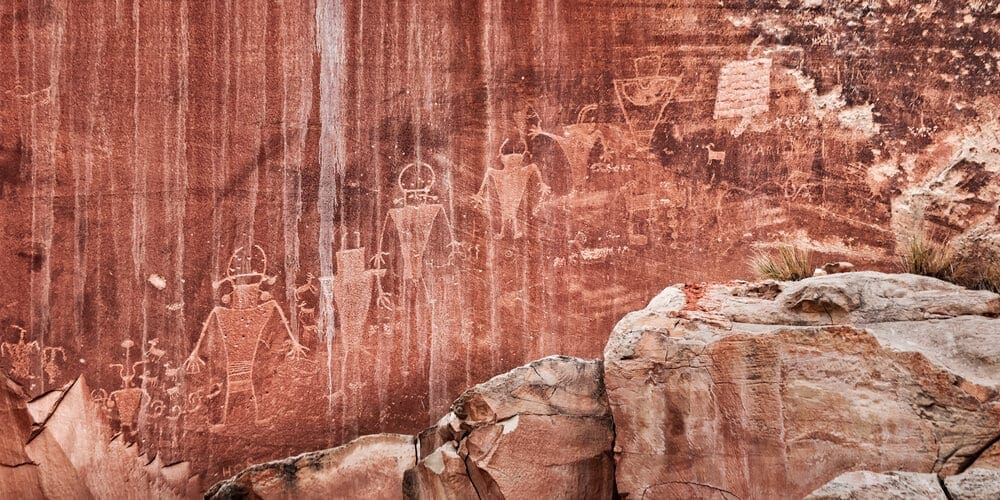
Prehistoric petroglyphs are a major draw in Capitol Reef National Park, Utah.
Hiking and Backpacking
There are more than enough incredible things to see right off the road in Capitol Reef. But if you have the time and the gusto to put a little work in, you’ll find some of the best stuff takes a little work to get to.
Near Fruita, there are a lot of outstanding hiking trails ranging from easy to strenuous. Most of them are fairly short, though in some cases the elevation gain can be intense. A few standouts are (listed from least difficult to most difficult): Capitol Gorge, Grand Wash, Hickman Bridge, Cassidy Arch, and the Fremont Gorge Overlook. These trails will lead you through otherworldly slot canyons, to historical inscriptions, natural arches and bridges, and panoramic views of the sprawling mesa.
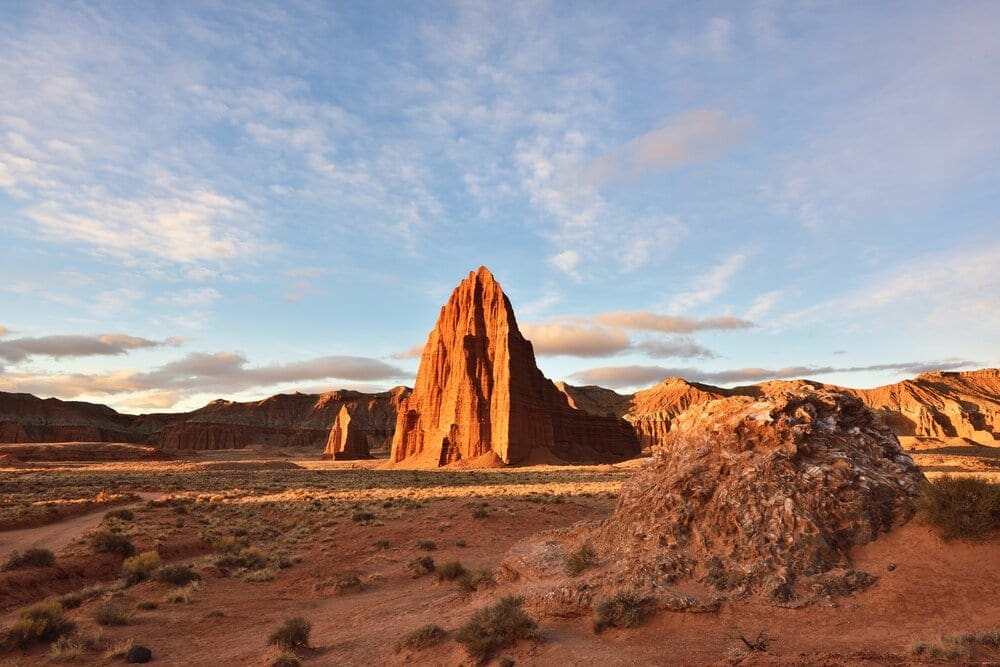
The Glass Mountain and Temple of the Sun at sunrise.
In the Cathedral District, be sure to get a view of the Temples of the Sun and Moon from above on the Lower Cathedral Valley Overlooks trail. For some longer distance, go for the Jailhouse Rock and Temple Rock trail. And in the Waterpocket District, check out the Strike Valley Overlook and Surprise Canyon.
If you’re looking to go for more than a day, there are some unreal backpacking routes through Capitol Reef. Spring Canyon can be done a number of ways with distances varying from just 2.9 miles to 33.2 miles. Upper Muley Twist Canyon is a short-but-sweet route that leads to some amazing rock formations, including Saddle Arch. And for the experienced thrill seeker, Halls Creek Narrows is a challenging two to three-day trek through the most remote corner of the park. You may have to ford standing water through winding slot canyons, but you’ll definitely be satisfied with this adventure.
Canyoneering and Climbing
If you feel like kicking it up a notch to take on something more sporty, you could try canyoneering. The southwest is full of beautiful slot canyons to hike, stem, and scramble through. Some require technical skills and gear to rappel long dryfalls, some require swimming through standing water, and others are essentially just more hands-on hikes.
Capitol Reef is home to lots of both technical and non-technical canyons that can be done in a day. But be warned that if you’re new to the sport, canyoneering is not to be taken lightly. People have lost limbs and died while canyoneering in Utah. Before you go, plan as much as you can, starting here. Understand the risks of flash flooding, and come prepared. Exploring the canyons of the Waterpocket Fold should not be done lightly, but will doubtlessly be a journey you’ll always remember.
There are also lots of great opportunities for rock climbing in Capitol Reef. Whether your flavor is big wall climbing or bouldering, there are good options throughout the park. A free permit is required for any climbing you plan on doing in the park.
Make sure you follow Leave No Trace ethics while climbing. Sandstone can be easily damaged if climbed when recently wet, and approaches to climbs should be followed closely as cryptobiotic soil covers most areas surrounding major climbs.
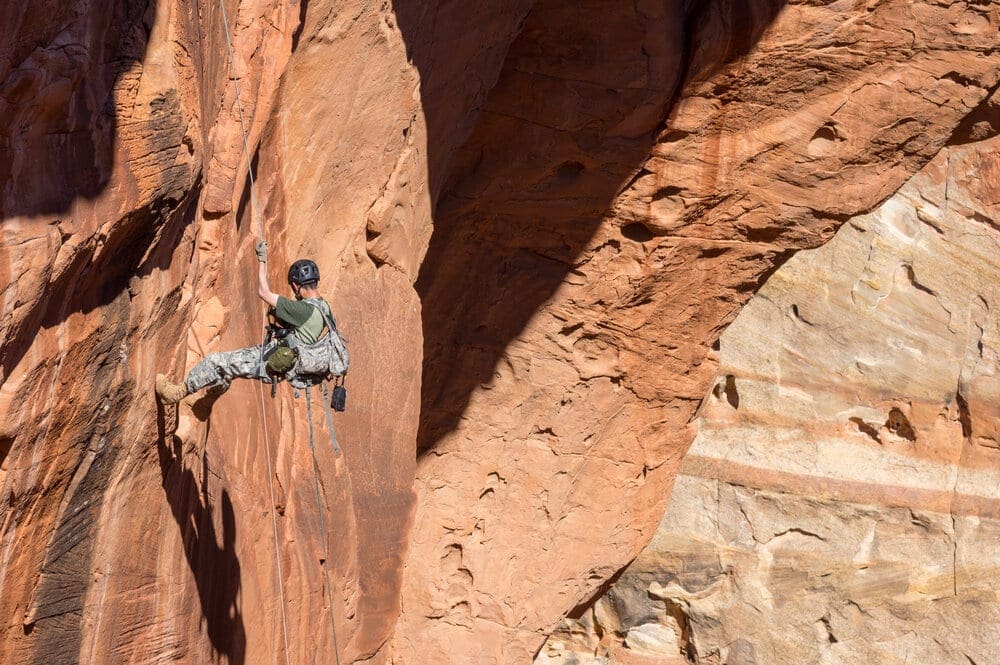
A climber rappels down a rock face in Capitol Reef National Park, Utah.
Bike Touring/Bikepacking
While there aren’t singletrack trails through Capitol Reef, the many dirt spur roads through the park offer some intriguing options for bike tours. These vary in length and difficulty somewhat, but expect to do some hill climbing. There are a few definite standouts here – the Cathedral Valley Loop, a 57.6 mile route through the barren northern district of the park; and the “North to South” route, for lack of a better name. This scarcely-done tour takes on the full length of the park from top to bottom, totaling 124 miles. Using the primitive campsites to overnight, you can traverse the entire Waterpocket Fold in a few days. It’s a big undertaking, but epic voyages usually are.
Backcountry Horseback Riding
For the real wild west experience, you can ride a horse through the park. Make sure to read up on rules for staging and keeping travel low-impact, as stock use tends to require more space and can disturb local ecosystems more easily than foot travel. There are fantastic rides across the park, including a trek across Cathedral Valley and the upper portion of Halls Creek (the narrows are off-limits to stock). You can even overnight with your pack animals, though you will have to coordinate your intended route with the park and get a permit before heading up the trail.
Treat Yourself To A Guided Adventure
If you’re looking to explore a new activity or deepen your mastery of an existing sport, it pays to invest in a professional. Guides not only ensure your safety when doing something for the first time, but they can also lead you off the beaten path and offer enlightening details about history, culture and geology. Plus, prepare yourself for captivating narratives no one else can tell. To hire an experienced local pro, you can use services such as 57Hours, or REI Adventures.
There are local guides for hiking, backpacking, climbing, canyoneering, mountain biking, ice climbing and backcountry skiing adventures throughout Utah. Journey across the Southwest’s picturesque trails while gaining insight into ancient cultures and learning about Utah’s geology and ecology.
REI Adventures
REI Adventures has created a vast selection of outdoor experiences based in America’s most iconic places, making its U.S. trip catalog over one hundred strong. Here are a few examples of their adventures at Capitol Reef National Park.
Capitol Reef & Escalante Hiking – Hotel Based: REI’s 6-day adventure in the Grand Staircase-Escalante National Monument offers a rare feeling of remoteness and ruggedness. REI’s top guide has selected off-the-beaten-path routes like abandoned pioneer trails, cliff dwellings, and seldom seen slot canyons. Relax by night in comfort and awe of one of Mother Nature’s most pristine playgrounds.
Utah National Parks Ultimate Adventure: Spend 8 days exploring the incredible national parks of southern Utah, and experience five of nature’s masterpieces. From Canyonlands to Arches, Capitol Reef to Bryce Canyon and Zion, this is an adventure you won’t forget. Hiking along awe-inspiring trails in the American Southwest during the day and relaxing in comfortable campsites at night are just a few things you’ll enjoy on this trip.
57Hours
If you don’t already know, 57hours is a service that connects weekend warriors like yourself with certified guides, so you can maximize your enjoyment on your days off. They have a large selection of multi-day hiking, climbing and mountain biking trip in Utah with local guides. Here are some examples of their many adventure opportunities:
High Five, Utah! Hike the Mighty Five National Parks: Take a tour of Southern Utah featuring hiking, jeeping, kayaking, and canyoneering. Sleep in cozy yurts and glamp under the starlit sky while exploring the Moab Desert and Zion Canyon. Explore the Grand Circle’s vibrant sandstone layers and take a voyage spanning eons of geologic time.
Mountain Biking in Dead Horse Point: Moab offers some of the best mountain biking in North America, and Dead Horse Point is one of the very best intermediate singletrack rides. Its Great Pyramid contours, Big Chief’s “alligator back” rock riding, and Whiptail’s views make for a dynamic and enjoyable experience you’ll want to recommend.
Rock Climbing Tower Pursuits in Moab: Utah’s Moab region is a climber’s dream. With twenty world-renowned towers and a knowledgeable guide, climbers of all levels will find routes ranging in difficulty from 5.7 to 5.11. The area offers breathtaking sandstone towers surrounded by captivating nature as far as the eye can see, making it one of the premier rock climbing spots in the USA. You won’t be disappointed.
48-Hour Astro Photography Tour at White Pocket: Who says magical moments can’t be captured? Join renowned photographer Cody York at White Pocket and discover the secrets of astrophotography in a dreamscape of swirling sandstone layers, illuminated by the dim light of the Milky Way.
Nearby Cities
Capitol Reef is, as mentioned above, very remote. The nearest major city is Salt Lake City, a three to four hour drive north. The next largest nearby town is Moab, about two hours east of the Reef. If your trip to Capitol Reef is part of a larger desert road trip, you’ll likely be heading to, or coming from Moab at some point. Your best bet for finding groceries or gassing up near Capitol Reef is probably Torrey, west of the park, or Hanksville, to the east. The southern district of the park is most easily accessed via Bullfrog, a small town and marina on Lake Powell. Most places nearby will have basic supplies available, and a few options for lodging if you’re in need of a shower and a bed.
The Whole Desert in Cross-Section
Capitol Reef will give you an appreciation for all the charms of the desert. Looming desert towers, colossal distances, ancient artworks, and adventure around every corner are the daily fare here. So consider this your call to action. The Waterpocket Fold is waiting for you.




